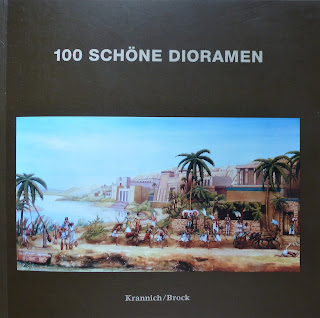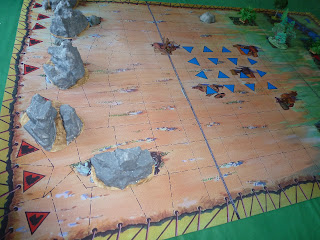Anyone who was a schoolboy in the 1960's will remember the Waddingtons board game of the Battle of the Little Big Horn, it came with some rather nice 40mm figures of General Custer, his 7th Cavalry and the opposing Sioux and Cheyenne Indians. Well sometime last year Anthony had the original board copied onto a 6'x4' mat for use with 54mm toy soldiers but the ensuing pandemic has prevented us playing it, until today, which by the purest of coincidence happens to be the 145th anniversary of the actual battle.
The Indian camp beyond the Little Big Horn river, the red triangles show the starting places for the Braves on foot, the blue triangles are the starting positions for Custer and the 7th Cavalry. Model trees and tepees give a bit of definition to the flat board.
At the other end of the board the red triangles show the starting places for the mounted Indians and their Chiefs, rock formations give a 3D effect to the board.
The figures we used were from the Britains Deetail range, the beauty of these is that they have metal bases which prevent them falling over all the time.
Victory conditions for the 7th Cavalry is either to escape across the river and exit the board with their flag or kill all of the three Indian Chiefs. Victory conditions for the Indians is to kill Custer, his two officers and capture the flag.
We played a trial game with the original rules and number of figures, we were surprised at how subtle and tactical the rules were, mistakes were inevitably made on both sides but in the spirit of good gamesmanship we helped each other to avoid the most disastrous outcomes. The game took about two hours to play and as you can see above it reflected the historical outcome. It was great fun, surprisingly challenging and we felt the game system could easily be adopted to other low intensity irregular conflicts, I already have a late 1940's French Indochina project in mind.

For those who like a bit of toy soldier trivia with their wargame reports this is the first version Zang/Herald tepee from the Indian encampment set. I don't know if you should call this rare or just hard to find but it differs from the ubiquitously common second version by having a short entrance flap with four diamonds above while the later one has a larger flap with just two diamonds above. Not many people know that. You really do have to be a boring old fart to be interested in this sort of minutiae!
And yes, it really was a complete coincidence that we played this game on the anniversary of the actual battle. We got so drawn in we could almost have been there on that fateful day in 1876, imagination can take you to these places, good job they don't let children get a taste of it.















